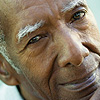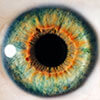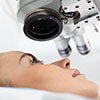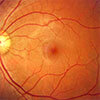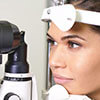The importance of managing dry eye prior to cataract surgery
We’ve all had the patient with uncorrected 20/20 acuity after cataract surgery, yet they are still expressing “20/unhappy” frustration with their day-to-day vision. Often one of the most unrecognized causes of patient dissatisfaction postoperatively is dry eye disease.1
According to the Prospective Health Assessment of Cataract Patients’ Ocular Surface (PHACO) study, more than 75 percent of patients presenting for cataract surgery had evidence of at least stage 2 dry eye (figure 1) yet nearly 60 percent had never complained of a foreign body sensation.2
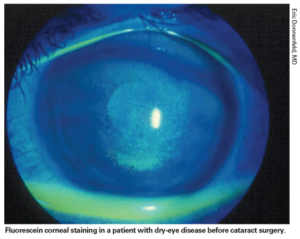
Figure 1
Dry eye disease is an extremely common pre-existing condition in patients planning for cataract surgery and can have significant consequences on various aspects of cataract surgery. An irregular ocular surface affects preoperative planning reducing the repeatability of keratometry readings and diminishing the accuracy of intraocular lens calculations. Research shows that treating dry eye preoperatively results in better visual outcomes, speed of recovery and postoperative satisfaction.3
Treating dry eye disease can be challenging due to its multifactorial etiology and no single dry eye management formula will suit all patients. Although dry eye disease is traditionally classified as either aqueous deficient or evaporative, the TFOS DEWS II report estimated that 30-70 percent of patients with symptoms of ocular surface disease had a variable combination of these two categories (figure 2).4 The ultimate goal in treating dry eye and ocular surface disease prior to cataract surgery is to reduce inflammation and restore the homeostasis of the surface of the eye and tear film as quickly as possible.
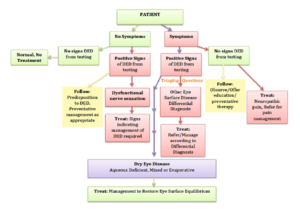
Figure 2: Classification of dry eye3
For patients with meibomian gland dysfunction and blepharitis, hot compresses, lid hygiene and oral nutritional supplements such as flaxseed oil or fish oils are initiated in combination with a cyclosporin. In more severe cases, Doxycycline can be considered and if there is significant SPK and inflammation, liftegrast and a short course of loteprednol may be prescribed to get the corneal epithelium in the best possible shape before proceeding with surgery. Improvement is often seen 2 weeks after initiation of treatment, but 4 weeks of therapy prior to surgery is preferred. This allows for stable, reproducible imaging and biometry, which is especially important for a patient hoping for Cataract Surgery with Vision Correction.5
Now more than ever, with premium IOLs, we have the ability to optimize patients’ vision after cataract surgery. This ability relies on the health of the ocular surface both pre- and postoperatively. Dr. Eric Donnenfeld says, “One cannot perform premium cataract surgery using premium lenses without ensuring a premium ocular surface.”6

We all want our patients to have a great experience when it is time for cataract surgery. To meet or exceed patient’s expectations of high quality vision, clinicians must pay special attention to ocular surface health and treat dry eye disease preoperatively.
- Gibbons A, Ali T, Waren D, Donaldson K. Causes and correction of dissatisfaction after implantation of presbyopia-correcting intraocular lenses. Clin Ophthalmol. 2016;10:1965–70.
- Trattler W, Majmudar P, Donnenfeld E, et al. The prospective health assessment of cataract patient (PHACO) study: the effect of dry eye. Clin Ophthalmol. 2017;11:1423-30.
- Chuang J, Shih KC, Chan T, Wan KH, Jhanji V, Tong L. Preoperative optimization of ocular surface disease before cataract surgery. J Cataract Refract Surg. 2017;43(12):1596-1607
- Craig JP, Nichols KK, Akpek EK, et al. TFOS DEWS II definition and classification report. Ocul Surf. 2017;15(3):276-83.
- Epitropoulos AT, Matossian C, Berdy GJ, Malhotra RP, Potvin R. Effect of tear osmolarity on repeatability of keratometry for cataract surgery planning. J Cataract Refract Surg. 2015 Aug;41(8):1672-7.
- Donnenfeld, E. Lessons From the PHACO Study. com. Jan/Feb 2018.
 Author: Kerri Svanda, OD
Author: Kerri Svanda, OD
Specialty: Medical Eye Care
Working on the cornea, cataract and refractive team allows me to combine my passion for refractive surgery with treating patient’s medical conditions. I chose this topic because premium IOLs have transformed cataract surgery into refractive surgery with outcomes often rivaling SMILE and LASIK. In order to help my patients achieve and maintain their best vision, I have to help them achieve and maintain a healthy, hydrated ocular surface.


